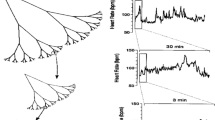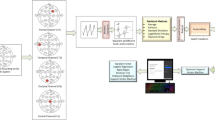Abstract
The aim of this work is to present a noninvasive method to classify normal voice signals and those corresponding to voice disorders. Use of wavelet decomposition is prevalent for feature extraction in this field and provides good frequency resolution in lower-frequency subbands. In this work, to provide better frequency resolution in higher-frequency subbands as well, we use M-band wavelet decomposition for feature extraction, employing a genetic algorithm to determine the parameters of the optimal wavelet. Moreover, a support vector machine is used as the final classifier. By employing a well-known pathological voice database, normal and pathological cases are classified using a five-band wavelet system for feature extraction, showing good performance.





Similar content being viewed by others
References
A. Akbari, M. Khalili Arjmandi, An efficient voice pathology classification scheme based on applying multi-layer linear discriminant analysis to wavelet packet-based features. Biomed. Signal Process. Control 10, 209–223 (2014)
J.D. Arias-Londono, J.I. Godino-Llorente, N. Saenz-Lechon, V. Osma-Ruiz, G. Castellanos-Dominguez, an improved method for voice pathology detection by means of a HMM-based feature space transformation. Pattern Recognit. 43, 3100–3112 (2010)
R. Behroozmand, F. Almasganj, Optimal selection of wavelet-packet-based features using genetic algorithm in pathological assessment of patients’ speech signal with unilateral vocal fold paralysis. J. Comput. Biol. Med. 37, 474–485 (2007)
C.M. Bishop, Pattern Recognition and Machine Learning (Springer, New York, 2006), p. 740
A. Dibazar, T. Berger, S. Narayanan, Pathological voice assessment, in Proceedings of the 28th Annual International Conference of the IEEE EMBS, New York (2006)
Disordered Voice Database, version 1.03, Massachusetts Eye and Ear Infirmary. KAY Elemetrics Corporation. Voice and Speech Lab, Boston, MA (1994).
N. Erfanian Saeedi, F. Almasganj, F. Torabinejad, Support vector wavelet adaptation for pathological voice assessment. J. Comput. Biol. Med. 41, 822–828 (2011)
N. Erfanian Saeedi, F. Almasganj, Wavelet adaptation for automatic voice disorder sortings. J. Comput. Biol. Med. 43, 609–704 (2013)
E.S. Fonseca, R.C. Guido, P.R. Scalassara, C.D. Maciel, J.C. Pereira, Wavelet time-frequency analysis and least squares support vector machines for the identification of voice disorders. J. Comput. Biol. Med. 37, 571–578 (2007)
R.C. Guido, J.C. Pereira, E.S. Fonseca, F.L. Sanchez, L.S. Vieira, Trying different wavelets on the search for voice disorders sorting, in Proceedings of the IEEE 37th International Southeastern Symposium on System Theory, pp. 495–499 (2005).
T. Hemalatha, K. Sukumar, K.P. Soman, Improving security of watermarking algorithms via parametric M-band wavelet transform, in Proceedings of the International Conference on Advances in Recent Technologies in Communication and Computing, pp. 360–362 (2009).
H. Khadivi Heris, B. Seyed Aghazadeh, N.B. Mansour, Optimal feature selection for the assessment of vocal fold disorders. Comput. Biol. Med. 39, 860–868 (2009).
M. Khalil Arjomandi, M. Pooyan, An optimum algorithm in pathological voice quality assessment using wavelet-packet-based features linear discriminant analysis and support vector machine. Biomed. Signal Process. Control 7, 3–19 (2012)
R. Linder, A.E. Albers, M. Hess, S.J. Poppl, R. Schonweiler, Artificial neural network-based classification to screen for dysphonia using psychoacoustic scaling of acoustic voice features. J. Voice 22(2), 155–163 (2008)
A. Maier, T. Haderlein, U. Eysholdt, F. Rosanowski, A. Batliner, M. Schuster, E. Nöth, PEAKS—a system for the automatic evaluation of voice and speech disorders. Speech Commun. 51(5), 425–437 (2009)
C.D. Paredes Crovato, A. Schuck, The use of wavelet packet transform and artificial neural networks in analysis and classification of dysphonic voices. IEEE Trans. Biomed. Eng. 54(10), 1898–1900 (2007)
R. Ramanathan, K.P. Soman, Improved technique for the construction of parametric M-band wavelets, in Proceedings of the International Conference on Advances in Recent Technologies in Communication and Computing, pp. 823–825 (2009).
R.T. Ritchings, M.A. McGillion, C.J. Moore, Pathological voice quality assessment using artificial neural networks. Med. Eng. Phys. 24, 561–564 (2002)
L. Salhi, M. Talbi, A. Cherif, Gammachirp wavelet and neural network for identification of pathological voices. J. Eng. Appl. Sci. 3(11), 822–828 (2008)
K. Shama, A. Krishna, N.U. Cholayya, Study of harmonics-to-noise ratio and critical-band energy spectrum of speech as acoustic indicators of laryngeal and voice pathology. EURASIP J. Adv. Signal Process. 2007, 1–9 (2007).
S.N. Sivanandam, S.N. Deepa, Introduction to Genetic Algorithm (Springer, Berlin, 2007).
K.P. Soman, K.I. Ramachandran, Insight into Wavelets-From Theory to Practice (Prentice-Hall, New Delhi, 2006)
V. Vapinik, Statistical Learning Theory (Wiley, New York, 1998)
G. Vaziri, F. Almasganj, R. Behroozmand, Pathological assessment of patients’ speech signals using nonlinear dynamical analysis. J. Comput. Biol. Med. 40, 54–63 (2010)
H. Wertzner, S. Schreiber, L. Amaro, Analysis of fundamental frequency, jitter, shimmer and vocal intensity in children with phonological disorders. Brazilian J. Otorhinolaryngol. 71(5), 582–588 (2005)
Author information
Authors and Affiliations
Corresponding author
Additional information
This work was carried out while P. Saidi was at Amirkabir University of Technology.
Rights and permissions
About this article
Cite this article
Saidi, P., Almasganj, F. Voice Disorder Signal Classification Using M-Band Wavelets and Support Vector Machine. Circuits Syst Signal Process 34, 2727–2738 (2015). https://doi.org/10.1007/s00034-014-9927-x
Received:
Revised:
Accepted:
Published:
Issue Date:
DOI: https://doi.org/10.1007/s00034-014-9927-x




